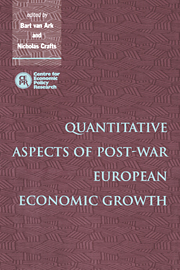Book contents
- Frontmatter
- Contents
- List of figures
- List of tables
- List of contributors
- Preface
- 1 Catch-up, convergence and the sources of post-war European growth: introduction and overview
- 2 Macroeconomic accounts for European countries
- 3 Sectoral growth accounting and structural change in post-war Europe
- 4 Measures of fixed capital stocks in the post-war period: a five-country study
- 5 Technology indicators and economic growth in the European area: some empirical evidence
- 6 Human capital and productivity in manufacturing during the twentieth century: Britain, Germany and the United States
- 7 Convergence and divergence in the European periphery: productivity in Eastern and Southern Europe in retrospect
- 8 Convergence: what the historical record shows
- 9 Growth and convergence in OECD countries: a closer look
- 10 On the historical continuity of the process of economic growth
- 11 Europe's Golden Age: an econometric investigation of changing trend rates of growth
- Index
7 - Convergence and divergence in the European periphery: productivity in Eastern and Southern Europe in retrospect
Published online by Cambridge University Press: 23 December 2009
- Frontmatter
- Contents
- List of figures
- List of tables
- List of contributors
- Preface
- 1 Catch-up, convergence and the sources of post-war European growth: introduction and overview
- 2 Macroeconomic accounts for European countries
- 3 Sectoral growth accounting and structural change in post-war Europe
- 4 Measures of fixed capital stocks in the post-war period: a five-country study
- 5 Technology indicators and economic growth in the European area: some empirical evidence
- 6 Human capital and productivity in manufacturing during the twentieth century: Britain, Germany and the United States
- 7 Convergence and divergence in the European periphery: productivity in Eastern and Southern Europe in retrospect
- 8 Convergence: what the historical record shows
- 9 Growth and convergence in OECD countries: a closer look
- 10 On the historical continuity of the process of economic growth
- 11 Europe's Golden Age: an econometric investigation of changing trend rates of growth
- Index
Summary
Introduction
Recent contributions to the literature on the catch-up and convergence performance of nation states have been either related to the growth experience of a ‘maximalist’ sample of countries, or they focused more narrowly on OECD countries. For the latter group the evidence on convergence of per capita income and productivity is quite strong in particular for the period 1950 to 1973. However, for larger samples of countries and other periods than the ‘golden age’, performance can only be explained within a catch-up and convergence framework when the model allows for a range of initial conditions for convergence, such as a minimum level of human and physical capital investment, a certain degree of openness to trade, etc.
Relatively few studies have dealt with catch-up and convergence from a regional or country-specific perspective. Comparisons across a region may be useful, because one might hypothesize that geographical closeness is one of the factors strengthening convergence. Similarities in terms of technological regimes, cultural and institutional inheritance, as well as the optimal functioning of technology diffusion mechanisms through trade and investment across the region, may be forceful mechanisms driving convergence.
In this chapter regional convergence and divergence is looked into by comparing the economic performance of European countries during the post-war period with emphasis on two countries in Eastern Europe and two in Southern Europe.
Table 7.1 presents the average relative levels of per capita income compared to the United States for Northwest Europe, Southern Europe and Eastern Europe for the period 1938–92 derived from Maddison (1995).
- Type
- Chapter
- Information
- Quantitative Aspects of Post-War European Economic Growth , pp. 271 - 326Publisher: Cambridge University PressPrint publication year: 1997
- 4
- Cited by



